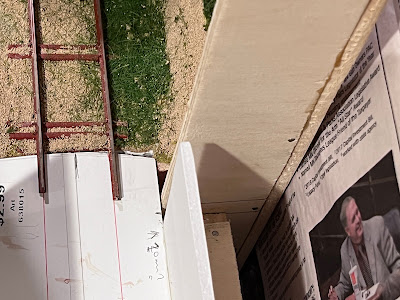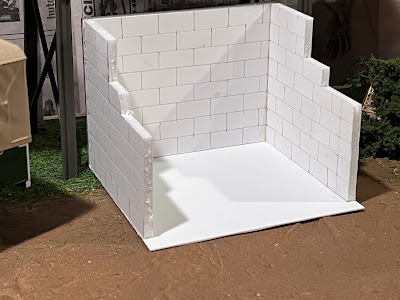We all progress in this hobby. As we spend more time working on our layouts, we develop. We learn skills. We become better at them, Then we learn new skills. Things that we thought impossible become easy. The bar becomes raised. Sometimes without even noticing it.
Then one day you do notice it. All the little steps amount to one big step. You’re left wondering how did I get here?
It was only a few years ago that I learned how to make my own panel track seen in this image. That too was a big step preceded by lots of little steps.
In this image there are many of the little steps since then, that lead to this next big step.
A 16mm scale Peter Binnie skip. This is a new scale to me. I actually don’t make many kits, and those I have started usually end up unfinished. I have half a dozen Slaters O scale wagon kits in such a state. This is a simple kit, little more than 10 parts so it got finished.
It’s battered and rusty. I don’t weather. I don’t trust myself. I don’t want to ruin really nice trains with some hamfisted dirty streaks. I buy R-T-R trains with weathering on them. The rim of the skip is banged up. As I don’t weather, I never thought about this before. This simple trick was suggested to me by another 16mm scale modeller. It’s a simple fix but it makes the wagon look like it’s been in service a while.
Static Grass. I have never used static grass until recently. While you were all covering your layouts with grass fibers from expensive, or even home built applicators. I was still in the last century using scatter materials. I had convinced myself that these fibers of grass were round whereas a blade of grass had width so the two couldn’t look the same. To a certain extent I still subscribe to that point of view. But the way those long fibers grow around the timber baulk buffer stop looks very pleasing.
The timber baulk is distressed, something else I hadn’t thought about until recently all you have to do is drag a razor saw blade down it. That’s not hard.
Weeds. The weeds are the last step. I have no idea why I thought modelling individual plants was something I could do. After all, I had seen Roy C Link’s nettles in his Crowsnest Tramway book, and thought to myself. Never.
It just seemed at that moment something I wanted/needed to try. I remembered that I had made many tiny trees for my Hitsu and Gonou T scale layouts. It couldn’t be any more difficult than that. I made about half a dozen, Then another dozen, followed by 20 more. Now I have about 40 weeds, a mix of Goldenrod, Ragwort and Cow Parsley to plant. It’s probably not enough. They are individually identifiable plants. A new skill has been learnt. A new step taken. Strangely, I find myself wanting to model nettles now.
I started to plant a few weeds on the layout. Ragwort at the sand pit end because they like sand. I pushed the skip up against the timber baulk. Just to see what it looked like.
That’s how I got here.
Looking at the scene, and the image, made me pause. I was gobsmacked. Without realizing it I had just raised my bar. All those small steps and decisions have pulled together to create a whole. The scene has a sense of place, an atmosphere. To a certain extent I feel like I’m there. To be honest, I want to go over there and tip that rusty old skip bucket over.
So I did.
So here I am. In a new place. A new realization that I can do whatever I put my mind to. I’m still a long way off the abilities of the true artists of the model railway world. But in my own way I think I’m with them. In spirit at least.





















































